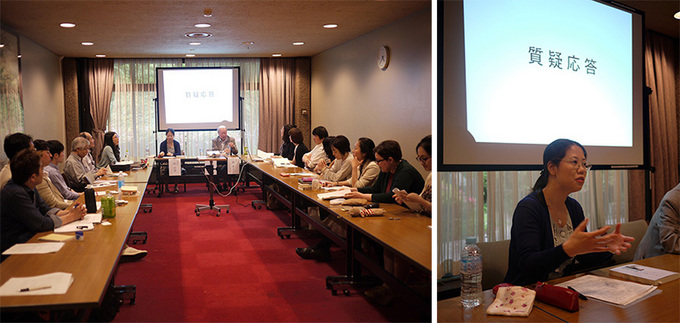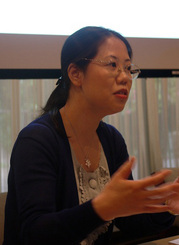"Libraries" in Haruki Murakami Literature: Examining the Komura Memorial Library of Kafka on the Shore in Particular
Bingjing Yang
Associate Professor, Japanese Department of Beijing Foreign Studies University
The library is one of the places that makes a frequent appearance in Haruki Murakami's novels. In his debut work Hear the Wind Sing the protagonist meets his third girlfriend, a university student majoring in French literature, at the university library. In 1Q84 the protagonist Aomame visits the public library to do some research. Murakami has even set some of his stories in libraries such as Hard-Boiled Wonderland and the End of the World, Kafka on the Shore, and Toshokan Kitan.
Upon closer examination, the libraries in Haruki Murakami's work may be sorted into two categories. The first is the library as a place to find information and conduct research, and the second is as a symbol for something, playing an important role. Japanese scholars have discussed the libraries in Murakami literature, especially in the latter context, from every angle. For example, Yoshinobu Hirano has asserted the following in his paper "Kimi wa kurai toshokan no oku ni hissori to ikitsuzukeru (You live quietly in the dark corner of the library)":
[...] it is simply because, just as the telephone device served as an interface connecting two distant spaces, the library, as a location (topos), was an interface linking the different times of past and future. (Kokubungaku kaishaku to kansho bessatsu, 2008, pp157-158)
Hirano perceives Haruki Murakami's libraries as a device connecting time, bringing an example of the telephone, a device connecting spaces. It may be said however that the relationship between the characteristics summed up by Hirano and other scholars and the essential nature of the library is yet to be investigated. The library, to begin with, possesses unique characteristics found in no other place, and this must be the fundamental reason why Murakami chose to feature libraries, especially as a kind of symbol in his work.
In this article, I will first clarify the essence of a library with clues drawn from its original nature, and then try to analyze the deeper meaning in Murakami's libraries, especially the Komura Memorial Library featured in Kafka on the Shore.

Kafka on the Shore by Haruki Murakami (Shincho Bunko)
The library as a place to preserve memories
The library becomes an integral part of our lives today, but it is not exactly as if there is a uniform definition of what it represents. Nevertheless, it is possible to establish a "library" being a place that accumulates and stores books and material for some sort of purpose, and just as the word suggests, a "library" consists of books and a place which keeps them. (In Japanese the library is called a toshokan, a combination of the words tosho, which means "books," and kan, which means "hall.")
Human communication is considered to have evolved in the four stages of oral, written, print, and electronic communication, and the invention of writing was probably the most significant event, having a dramatic impact on society. With the means to write, information was no longer something that had to be "memorized"; it could now be "recorded." This increase in recorded content gave rise to the problem of storing that content in an orderly fashion, and that led to the birth of the library. But simply collecting administrative or economic documents does not make a library; it is only with the collection of "writings that do not merely record some matter of fact but involve mental activity" (Lionel Casson, Libraries in the Ancient World, 2007) or "books that are the medium of conveying human knowledge, learning, or thoughts" (Koji Oguro, Tosho oyobi toshokanshi, 2000) that we see the start of a library.
Incidentally, what is meant by "mental activity" or "writings that involve mental activity?" Probably everyone has had the experience of registering and retaining details of what goes on around us in the world or the things that happen to us, and then playing them back by remembering them later. This can be described as the steps of forming a memory, the most important mental activity of a human being. The crucial element here is that each stage of registering, retaining, and recalling is not simply about creating a complete copy or recreation of the world or events that surround us. They are always accompanied by a subjective choice; we choose what we remember. In other words, the mental activity of memory formation is complex and at the bottom lies values that have been created by the community. Therefore, "writings that involve mental activity" reflect a community's perception of the outer world and a certain set of shared values. As a place to archive these documents, the library is a kind of vessel, where recorded memories are gathered and where there is an undercurrent of collective values.
The library as a place that is needed
The first reason why Haruki Murakami frequently features libraries in his work is probably because he wants to use the essential nature of the library. Since the library is a place archiving "memories" that are recorded through collective values, if you were to go to a library for some research, all you need to do is turn the pages of the necessary material and that would complete your mission. But what really matters is that Haruki Murakami seems to have given the library some sort of deeper meaning besides the essential nature of the library, treating it as some kind of symbol. Thus, how does this library relate to the essence of the library?
Of the libraries with symbolic significance, the Komura Library in Kafka on the Shore is one of the most prominent, and Yoshinobu Hirano has even described Kafka on the Shore as "a wild library chase." In Kafka on the Shore, the Komura Library first appears in chapter five. The boy Kafka had once seen a picture of the private library situated in the suburbs of Takamatsu City in Taiyo magazine. The name of this library is the Komura Memorial Library, and he finds that "some wealthy man from an old family had refurbished his personal library into a private library open to the public." He notes that "The place has a lot of rare books, and I heard that the building itself and the surrounding garden were worth checking out." "For some reason that photo really stayed with me" says Kafka, and maybe because of this, he leaves home on his 15th birthday to head straight for this Komura Library.
Thus, the Komura Library had been featured as Kafka's destination, but actually other people in Kafka on the Shore also head for or return to the Komura Library. A second plot that runs parallel to Kafka's story involves Nakata, who has suffered memory loss, and he heads west from Tokyo, as Kafka does, to finally reach the front gate of Komura Library in the suburbs of Takamatsu City. Meanwhile, Miss Saeki, who used to be a girlfriend of the eldest son of the Komura family, suddenly returns to Takamatsu after a 25-year lapse, and becomes the manager of the Komura Library.
These three important characters of the novel--Kafka, Nakata, and Miss Saeki--are all see the Komura Library as their destination. Therefore, the Komura Library is not simply a place where the main characters come together, but a place that harbors what Kafka and Nakata desire and for Miss Saeki of extreme importance.
The library as a black box of life
"The world is a metaphor, Kafka Tamura," he says into my ear.
"But for you and me this library alone is no metaphor. It's always just this library. I want to make sure we understand that."
"Of course," I say.
"It's a unique, special library. And nothing else can ever take its place."
I believe this conversation between Oshima and Kafka in the last pages of Kafka on the Shore can tell the secret of the Komura Library. To start with my conclusion, the Komura Library is like a black box that records everyone's lives, a place that preserves each of the memories of Kafka, Nakata, manager Miss Saeki, and librarian Oshima. If they seek an answer, they only get to find the record of their own life, and that is why "the library alone is no metaphor," and "a unique, special library," since it only stores their memories.
As mentioned above, for Kafka and Nakata, the Komura Library is the place that holds what they seek, and for Miss Saeki, a place of extreme significance. Of these three characters, let us pay special attention to Miss Saeki. She returns to her hometown and comes to be in charge of the Komura Library, and every day she works on her manuscript in the study on the second floor of the library. The Komura Library had been a paradise for the young Miss Saeki and her boyfriend, hence it is a place full of memories of her youth and probably the memories most precious to her. For Miss Saeki, returning to Komura Library enables her to make her own memories a "record," and in that sense, the Komura Library and Miss Saeki have an inseparable relationship. She is almost part of the contents of the Komura Library, and also the key person for Kafka and Nakata.
In fact, Nakata and Kafka acquire memories in different forms through Miss Saeki, and embrace the final moments of life, in the case of Nakata, or of the future, in the case of Kafka.
Since the essential nature of the library is a place to preserve recorded memories, the Komura Library featured in Kafka on the Shore serves as a place to store memories, and as a kind of black box that records all lives. Perhaps this is the deeper meaning with which Haruki Murakami invests the Komura Library.
As the Komura Library preserves the memories of the three main characters, I believe a consolidated look at their memories also articulates the history of Japan from just before World War II to around the year 2000; and going back further, the evolution of the Komura Library also reflects the modernization of Japan. In the future, I hope to examine how both the memories of the individual and collective memories of the community interact in this special space of the Komura Library and how they resonate towards the future.
(Text revised according to the special lecture of Haruki Murakami study group from the Department of Chinese Language and Literature, The University of Tokyo, held at Sanjo Conference Hall, The University of Tokyo on June 1, 2013. Originally in Japanese.)

(Left) Special lecture of Haruki Murakami study group from the Department of Chinese Language and Literature, The University of Tokyo
(Right) Bingjing Yang responding to questions at the venue
Photos courtesy of: Haruki Murakami study group, Department of Chinese Language and Literature, The University of Tokyo
Acknowledgements: On writing this paper, I would like to express my sincere appreciation for the precious advice from my joint-study partner Associate Professor Bingbing Guan of Zhejiang Yuexiu University of Foreign Languages. I would also like to thank Dr. Shinsuke Terauchi of the Beijing Foreign Studies University Japanese Department who was kind enough to proofread each of my Japanese manuscripts.
 Bingjing Yang
Bingjing Yang
Associate Professor of the Beijing Foreign Studies University Japanese Department. Yang currently resides in Japan under the Japan Foundation Japanese Studies Fellowship Program for a year from October 2012, and studies the lineage of post-war Japanese literature until Haruki Murakami.
Keywords
- Literature
- Japan
- Haruki Murakami
- Library
- Kafka on the Shore
- Komura Memorial Library
- Beijing Foreign Studies University
- Hear the Wind Sing
- 1Q84
- Hard-Boiled Wonderland and the End of the World
- Toshokan Kitan
- Yoshinobu Hirano
- Lionel Casson
- Koji Oguro
- University of Tokyo
- Bingbing Guan院
- Bingbing Guan
- Shinsuke Terauchi
Back Issues
- 2019.8. 6 Unraveling the Maker…
- 2018.8.30 Japanese Photography…
- 2017.6.19 Speaking of Soseki 1…
- 2017.4.12 Singing the Twilight…
- 2016.11. 1 Poetry? In Postwar J…
- 2016.7.29 The New Generation o…
- 2016.4.14 Pondering "Revitaliz…
- 2016.1.25 The Style of East As…
- 2015.9.30 Anime as (Particular…
- 2015.9. 1 The Return of a Chin…

